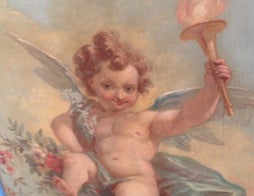What started as a site visit for an advanced conservation course turned into a nearly heart-stopping discovery.
Professor Frances Ford and students in the graduate program in historic preservation (a joint program between the College of Charleston and Clemson University) traveled to Rhode Island hoping to uncover an artistic sky on the ceiling of a historic mansion. As they worked on removing the top layers of paint, they found much more.
THE DISCOVERY
“The first hint of red and gold swirls was almost heart stopping because it was so unexpected,” explains graduate student Kendy Altizer.
As they continued removing the top layers of paint, they discovered a canvas with an oil painting of a cherub.
“Frances and I both squealed when we uncovered the cherub’s eye, we were absolutely amazed at both the quality and excellent condition of the painting.”
[Related: View more photos of the hidden painting.]
As they continued to reveal more of the hidden painting, graduate student Will Smith remembered seeing something in his pre-trip research. He found a picture of the room that appeared in a 1897 issue of Munsey’s Magazine. It shows the ceiling with a total of eight cherubs around a center medallion.
“The painting is clearly done by an artist of some renown,” explains Frances Ford, historic preservation professor and architectural conservator who specializes in paint analysis. “The mansion was built by Richard Morris Hunt, who is also the architect of the Biltmore Estate, so he must have been working with the best craftsmen of the time.”
WHAT’S NEXT?
The team brought samples of the painted sky back to Charleston and plan to conduct in-depth paint analysis at their lab on Meeting Street. The analysis will identify the pigments and binder used in the “painted sky” so that the proper solvent can be used in the restoration of the canvas.
Ford and the students will prepare a report with their recommendations for the next steps. Their hope is that the ceiling will be fully restored with all eight cherubs uncovered.
It’s something in which Altizer has taken a special interest. She’ll graduate with her M.A. in May and has already been accepted to a Ph.D. program, but she’s leaving the door to this project open.
“To actually uncover a very elaborate painting was really amazing,” Altizer says. “I would love the opportunity to continue the work, which we have already begun.”
[Related: Read about the discovery in the Post & Courier.]
FULL CIRCLE
This course clearly leaves a lasting impact. Professor Frances Ford modeled it after one of her favorite graduate school classes. The site work in her class was done on the ceiling of a 15th century chapel in Iglesia San Jose, Puerto Rico, which she still fondly remembers.
“This class really gets into the science of conservation and shows students the mechanics of paint analysis. Then, we’re able to visit a site, which really solidifies the experience for students.”
For more information, contact Frances Ford at [email protected].







